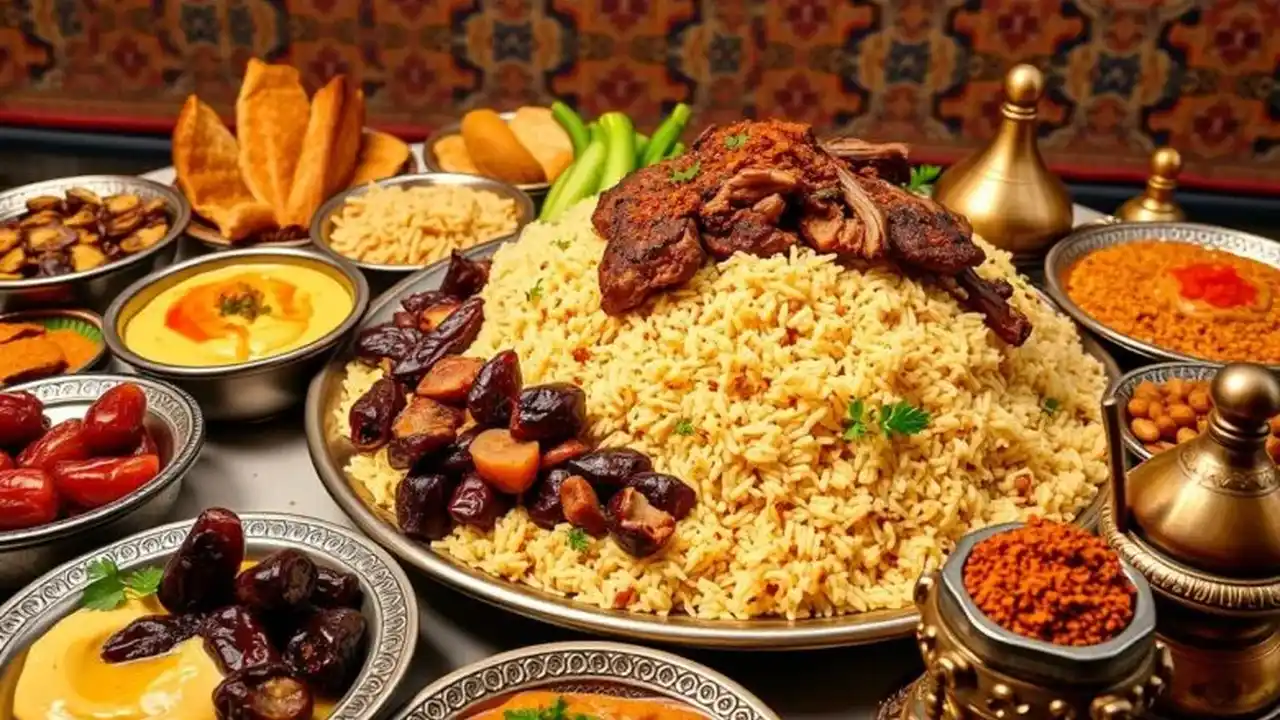
Embark on a flavorful adventure through the heart of Saudi Arabia with this guide to 10 must-try dishes. Discover the rich culinary heritage, unique ingredients, and tantalizing tastes that define Saudi Arabian cuisine. From savory mains to sweet treats, prepare your palate for an unforgettable experience.
Exploring Saudi Arabian Cuisine A Cultural Tapestry
Saudi Arabian cuisine is more than just food; it's a reflection of the country's rich history, diverse geography, and vibrant culture. Influenced by Bedouin traditions, trade routes, and neighboring countries, Saudi cuisine offers a unique blend of flavors and textures. It's a cuisine built on hospitality, generosity, and sharing, often enjoyed in communal settings with family and friends.
The ingredients used in Saudi dishes are as diverse as the landscape itself. Dates, rice, lamb, chicken, and an array of spices form the foundation of many meals. Saffron, cardamom, cumin, and coriander are just a few of the aromatic spices that add depth and complexity to the dishes. Fresh herbs like mint, parsley, and cilantro provide a refreshing contrast to the rich flavors.
Kabsa The National Dish of Saudi Arabia
Kabsa reigns supreme as the national dish of Saudi Arabia. This fragrant rice dish is a staple in households and restaurants across the country. It typically consists of long-grain rice (usually basmati), meat (chicken, lamb, or camel), vegetables, and a blend of spices. The rice is cooked in a flavorful broth until tender and infused with the aromatic spices.
The Secret to Perfect Kabsa: The key to a truly exceptional Kabsa lies in the quality of the ingredients and the careful balance of spices. Each family has their own secret recipe, passed down through generations. Some add tomatoes, others carrots, and still others a touch of chili for a subtle kick.
Kabsa Recipe Variations Exploring Regional Differences
While the basic concept of Kabsa remains the same, regional variations abound. In some regions, the rice is cooked with saffron for a vibrant yellow hue. In others, dried fruits like raisins and apricots are added for a touch of sweetness. You might also find Kabsa served with a side of raita, a cooling yogurt-based sauce.
Product Recommendation: For the best Kabsa, use high-quality Basmati rice. I highly recommend Royal Basmati Rice. It's long-grain, aromatic, and cooks perfectly every time. A 5kg bag costs around $25.
Kabsa Use Cases When to Serve This Iconic Dish
Kabsa is a versatile dish that can be enjoyed for any occasion. It's a popular choice for family gatherings, celebrations, and special events like Eid. It's also a common dish served to guests as a sign of hospitality. You'll find Kabsa on the menu at restaurants ranging from humble eateries to upscale dining establishments.
Kabsa Comparative Analysis Chicken vs Lamb vs Camel
The choice of meat in Kabsa significantly impacts the overall flavor profile. Chicken Kabsa is lighter and more delicate, while Lamb Kabsa is richer and more robust. Camel Kabsa, a delicacy in some regions, offers a unique gamey flavor. Consider your personal preferences and the occasion when choosing the type of meat.
Mandi A Slow Cooked Meat Masterpiece
Mandi is another popular rice dish in Saudi Arabia, particularly prevalent in the southern regions. What sets Mandi apart is the way the meat is cooked. It's traditionally slow-cooked in a tandoor oven, a clay oven buried in the ground. The meat is suspended above the rice, allowing the juices to drip down and infuse the rice with flavor.
The Art of Slow Cooking: The slow cooking process is crucial to achieving the tender, melt-in-your-mouth texture of the meat in Mandi. It allows the flavors to meld together beautifully, resulting in a truly unforgettable culinary experience.
Mandi Preparation Techniques Unveiling the Secrets
Preparing Mandi is a time-consuming process, but the end result is well worth the effort. The meat is typically marinated in a blend of spices before being placed in the tandoor oven. The rice is cooked separately and then layered with the meat before serving. It's often garnished with fried onions, nuts, and raisins.
Product Recommendation: To achieve the authentic Mandi flavor at home, consider using a portable tandoor oven. These ovens are designed to replicate the heat and smoky flavor of traditional tandoor ovens. A good quality portable tandoor oven costs around $500.
Mandi Serving Suggestions Traditional Accompaniments
Mandi is typically served on a large communal platter, with the rice and meat arranged in a visually appealing manner. It's often accompanied by a side of Sahawiq, a spicy Yemeni salsa, and a cooling yogurt sauce. The dish is typically eaten with the right hand, using pieces of flatbread to scoop up the rice and meat.
Mandi and Kabsa A Detailed Comparison
While both Kabsa and Mandi are rice-based dishes, they differ in several key aspects. Kabsa is typically cooked in a pot on the stovetop, while Mandi is slow-cooked in a tandoor oven. Kabsa generally has a more complex spice blend, while Mandi relies on the natural flavors of the meat and rice. Ultimately, the choice between Kabsa and Mandi comes down to personal preference.
Saleeg A Creamy Rice Delight
Saleeg is a creamy rice dish originating from the Hejaz region of Saudi Arabia. It's made with short-grain rice, milk, and butter. The rice is cooked in milk until it becomes soft and creamy, similar to a risotto. It's typically served with grilled or roasted chicken.
Simplicity at its Finest: What makes Saleeg so appealing is its simplicity. It requires only a few ingredients, but the end result is incredibly flavorful and comforting.
Saleeg Ingredients Sourcing the Best Quality
The key to a delicious Saleeg is using high-quality ingredients. Look for short-grain rice that is specifically designed for creamy dishes, such as Arborio rice. Use whole milk for a richer flavor and unsalted butter to control the saltiness of the dish.
Product Recommendation: For the creamiest Saleeg, use Carnaroli rice. It's a premium short-grain rice that releases more starch, resulting in an exceptionally creamy texture. A 1kg bag costs around $10.
Saleeg Cooking Techniques Mastering the Creaminess
Cooking Saleeg requires patience and attention. The rice needs to be stirred frequently to prevent it from sticking to the bottom of the pot. The milk should be added gradually, allowing the rice to absorb the liquid before adding more. The dish is done when the rice is soft and creamy, and the milk has thickened.
Saleeg Variations Exploring Regional Twists
While the basic recipe for Saleeg remains the same, regional variations exist. Some add cardamom or saffron for a more aromatic flavor. Others add a touch of cream or cheese for extra richness. Experiment with different variations to find your favorite.
Jareesh A Hearty Wheat Porridge
Jareesh is a traditional Saudi Arabian dish made from coarsely ground wheat, meat (usually lamb or chicken), and vegetables. It's a hearty and filling dish, perfect for cold weather. The wheat is cooked in a flavorful broth until it becomes soft and porridge-like.
A Taste of Tradition: Jareesh is a dish that has been enjoyed in Saudi Arabia for centuries. It's a reminder of the country's agricultural heritage and the importance of wheat in the local diet.
Jareesh Nutritional Benefits A Wholesome Meal
Jareesh is a highly nutritious dish, packed with fiber, protein, and vitamins. The wheat provides a good source of complex carbohydrates, while the meat provides essential amino acids. The vegetables add vitamins and minerals, making it a complete and balanced meal.
Product Recommendation: To simplify the Jareesh preparation, consider using a pressure cooker. It significantly reduces the cooking time and ensures that the wheat is cooked evenly. A good quality pressure cooker costs around $80.
Jareesh Preparation Methods Tips and Tricks
Preparing Jareesh can be a time-consuming process, but there are ways to simplify it. Soaking the wheat overnight will help it cook faster. Using a pressure cooker will also significantly reduce the cooking time. Adding a touch of lemon juice or vinegar will help tenderize the meat.
Jareesh Serving Suggestions Garnishing and Accompaniments
Jareesh is typically served hot, garnished with fried onions, chopped parsley, and a drizzle of olive oil. It can also be served with a side of yogurt or a squeeze of lemon juice. The dish is often eaten with bread or crackers.
Mathloutha A Sweet Treat with Dates
Mathloutha is a traditional Saudi Arabian dessert made from dates, flour, and ghee (clarified butter). It's a sweet and rich treat, often served with coffee or tea. The dates are mashed and mixed with flour and ghee, then baked until golden brown.
The Sweetness of Saudi Arabia: Mathloutha is a perfect example of how dates are used in Saudi Arabian cuisine. Dates are a staple ingredient, used in both sweet and savory dishes.
Mathloutha Ingredients The Importance of Quality Dates
The key to a delicious Mathloutha is using high-quality dates. Look for dates that are soft, plump, and moist. Medjool dates are a popular choice for Mathloutha due to their rich flavor and soft texture.
Product Recommendation: For the best Mathloutha, use Medjool dates. They're incredibly sweet and have a caramel-like flavor. A 1kg box costs around $20.
Mathloutha Baking Techniques Achieving the Perfect Texture
Baking Mathloutha requires careful attention to temperature and timing. The dough should be baked at a moderate temperature until golden brown and slightly firm to the touch. Overbaking will result in a dry and crumbly Mathloutha.
Mathloutha Variations Adding Your Own Touch
While the traditional recipe for Mathloutha is simple, you can add your own touch by incorporating different ingredients. Some add cardamom, cinnamon, or other spices. Others add nuts, such as almonds or walnuts. Experiment with different variations to find your favorite.
Umm Ali A Bread Pudding Delight
Umm Ali is a popular Middle Eastern dessert, also enjoyed in Saudi Arabia. It's a creamy bread pudding made with puff pastry, milk, cream, nuts, and raisins. The puff pastry is soaked in a mixture of milk and cream, then baked until golden brown and bubbly.
A Comforting Classic: Umm Ali is a comforting and indulgent dessert, perfect for satisfying your sweet tooth.
Umm Ali Ingredients Choosing the Right Puff Pastry
The key to a delicious Umm Ali is using high-quality puff pastry. Look for puff pastry that is flaky and buttery. You can use store-bought puff pastry or make your own from scratch. The nuts and raisins should be fresh and of good quality.
Product Recommendation: To save time, use store-bought puff pastry sheets. Ensure they are all-butter for the best flavor. A package of two sheets costs around $8.
Umm Ali Baking Methods Achieving the Golden Brown Top
Baking Umm Ali requires careful attention to temperature and timing. The pudding should be baked at a moderate temperature until golden brown and bubbly. The top should be slightly caramelized, but not burnt.
Umm Ali Serving Suggestions Warm and Indulgent
Umm Ali is typically served warm, garnished with a sprinkle of cinnamon or powdered sugar. It can also be served with a scoop of vanilla ice cream or a dollop of whipped cream. The dessert is best enjoyed fresh, as the puff pastry tends to become soggy over time.
Qahwa Saudi Coffee A Symbol of Hospitality
Qahwa, or Saudi coffee, is more than just a beverage; it's a symbol of hospitality and generosity in Saudi Arabian culture. It's typically made with lightly roasted Arabica coffee beans, cardamom, and saffron. The coffee is brewed in a traditional dallah pot and served in small, handleless cups.
The Art of Coffee Making: Preparing and serving Qahwa is an art form. The coffee is brewed slowly and carefully, and the serving ritual is steeped in tradition.
Qahwa Preparation The Traditional Brewing Process
Preparing Qahwa involves several steps. The coffee beans are lightly roasted and ground. The ground coffee is then boiled with water and cardamom in a dallah pot. Saffron is often added for flavor and color. The coffee is then strained and served in small cups.
Product Recommendation: For authentic Qahwa, use a traditional dallah pot. These pots are designed to keep the coffee warm and allow for easy pouring. A good quality dallah pot costs around $50.
Qahwa Serving Etiquette The Ritual of Hospitality
Serving Qahwa is a ritual steeped in tradition. The coffee is typically served by the host, who pours the coffee into small cups. The cups are usually filled only halfway, and the host continues to refill the cups until the guest indicates that they have had enough. It's considered impolite to refuse Qahwa when offered.
Qahwa Variations Exploring Different Flavors
While the traditional recipe for Qahwa is simple, variations exist. Some add cloves, ginger, or other spices. Others add a touch of sugar or honey. Experiment with different variations to find your favorite.
Laban A Refreshing Yogurt Drink
Laban is a refreshing yogurt drink popular in Saudi Arabia and throughout the Middle East. It's made by diluting yogurt with water and adding salt. It's a cooling and hydrating beverage, perfect for hot weather.
A Thirst Quencher: Laban is a staple beverage in Saudi Arabia, often served with meals or as a refreshing snack.
Laban Preparation A Simple and Refreshing Drink
Preparing Laban is simple. Yogurt is diluted with water to the desired consistency. Salt is added to taste. The mixture is then stirred until smooth and chilled before serving.
Product Recommendation: For the best Laban, use Greek yogurt. It's thicker and creamier than regular yogurt, resulting in a more flavorful Laban. A tub of Greek yogurt costs around $6.
Laban Health Benefits Hydration and Probiotics
Laban is a healthy and hydrating beverage. It's a good source of probiotics, which are beneficial bacteria that support gut health. It's also a good source of calcium and protein.
Laban Variations Adding Flavor and Freshness
While the traditional recipe for Laban is simple, variations exist. Some add mint, cucumber, or other herbs. Others add a squeeze of lemon juice or lime juice. Experiment with different variations to find your favorite.
Dates A Sweet and Nutritious Fruit
Dates are a staple food in Saudi Arabia, prized for their sweetness, nutritional value, and cultural significance. They are a versatile ingredient, used in both sweet and savory dishes. Dates are a rich source of energy, fiber, vitamins, and minerals.
The Fruit of the Desert: Dates are perfectly adapted to the arid climate of Saudi Arabia. They are a symbol of resilience and abundance.
Date Varieties Exploring the Different Types
There are many different varieties of dates grown in Saudi Arabia, each with its own unique flavor and texture. Medjool dates are large, soft, and caramel-like. Ajwa dates are small, dark, and chewy. Sukkari dates are golden brown and melt-in-your-mouth sweet.
Product Recommendation: Try a variety pack of Saudi Arabian dates to experience the different flavors and textures. A variety pack costs around $30.
Date Nutritional Benefits A Powerhouse of Nutrients
Dates are a powerhouse of nutrients. They are a rich source of energy, fiber, potassium, magnesium, and antioxidants. They are also a good source of iron and calcium.
Date Uses Culinary Applications and Beyond
Dates are a versatile ingredient, used in a variety of culinary applications. They can be eaten fresh, dried, or processed into date paste, date syrup, or date sugar. They are used in desserts, savory dishes, and beverages. Dates are also used in traditional medicine.
:max_bytes(150000):strip_icc()/277019-baked-pork-chops-with-cream-of-mushroom-soup-DDMFS-beauty-4x3-BG-7505-5762b731cf30447d9cbbbbbf387beafa.jpg)






